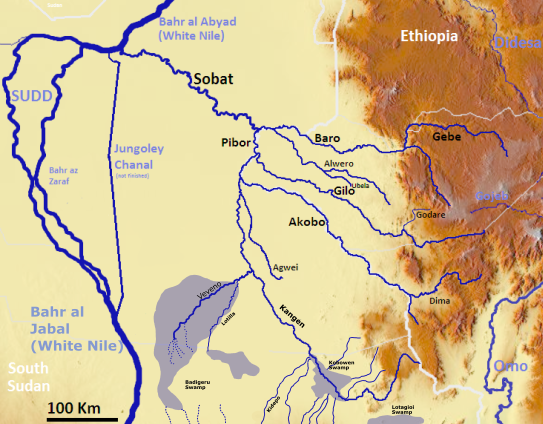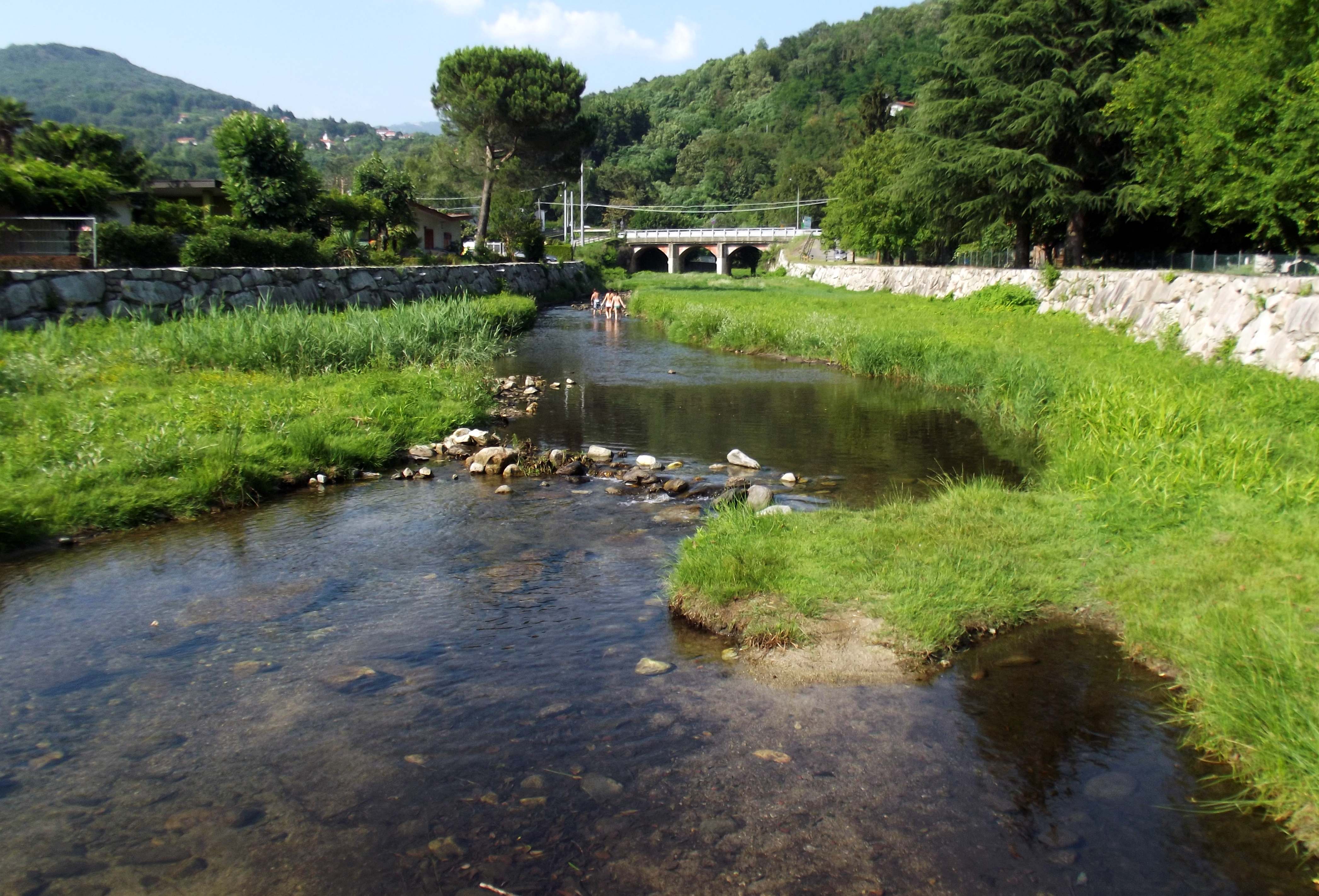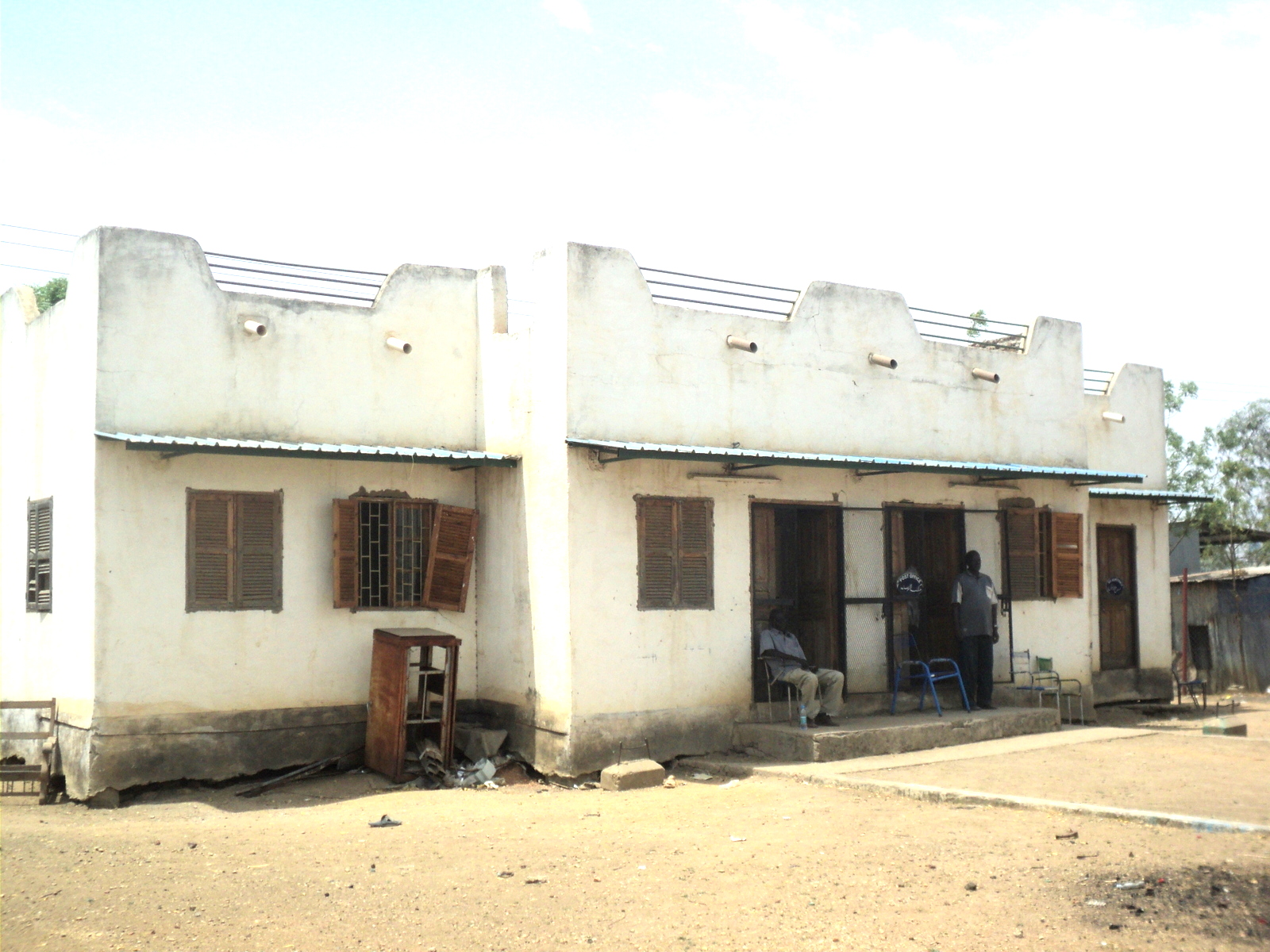|
Sobat River
The Sobat River is a river of the Greater Upper Nile region in northeastern South Sudan, Africa. It is the most southerly of the great eastern tributaries of the White Nile, before the confluence with the Blue Nile. Geography The Sobat River is formed by the confluence of the west-flowing Baro River and the north-flowing Pibor River, on the border with Ethiopia. The river enters the White Nile at Doleib Hill, near the city of Malakal in Upper Nile State. When in flood the Sobat River produces an enormous discharge carrying a white sediment, which gives the White Nile its name. Hydrology The Sobat and its tributaries drain a watershed approximately in size. The river's mean annual discharge is 412 m³/s (14,550 ft³/s).; online aGoogle Books/ref> See also *List of rivers of South Sudan This is a list of streams and rivers in South Sudan, arranged geographically by drainage basin. There is an alphabetic list at the end of this article. The list may not be comprehe ... [...More Info...] [...Related Items...] OR: [Wikipedia] [Google] [Baidu] |
South Sudan
South Sudan (), officially the Republic of South Sudan, is a landlocked country in East Africa. It is bordered on the north by Sudan; on the east by Ethiopia; on the south by the Democratic Republic of the Congo, Uganda and Kenya; and on the west by the Central African Republic. South Sudan's diverse landscape includes vast plains and plateaus, dry and tropical savannahs, inland floodplains, and forested mountains. The Nile, Nile River system is the defining physical feature of the country, running south to north across its center, which is dominated by a large swamp known as the Sudd. South Sudan has a population of just over 12.7 million in 2024. Juba is the Capital city, capital and largest city. Sudan was occupied by History of Egypt under the Muhammad Ali dynasty, Egypt under the Muhammad Ali dynasty and governed as an Anglo-Egyptian Sudan, Anglo-Egyptian condominium until Sudanese independence in 1956. Following the First Sudanese Civil War, the Southern Sudan Autonomous ... [...More Info...] [...Related Items...] OR: [Wikipedia] [Google] [Baidu] |
Greater Upper Nile
The Greater Upper Nile () is a region of northeastern South Sudan. It is named for the White Nile (it is its lowest portion in South Sudan), a tributary of the Nile River in North Africa, North and East Africa, East Africa. History The Greater Upper Nile region seceded from the Sudan, Republic of Sudan on 9 July 2011 along with its fellow Southern Sudanese regions of Bahr el Ghazal (region of South Sudan), Bahr el Ghazal and Equatoria. The three regions now constitute the South Sudan, Republic of South Sudan. Geography The Greater Upper Nile borders Ethiopia to the east and the Republic of Sudan to the north. The South Sudanese region of Bahr el Ghazal lies to the west and the region of Equatoria lies to the South of Greater Upper Nile. Administrative divisions The Greater Upper Nile consists of the following States of South Sudan, states: * Jonglei State * Unity (state), Unity * Upper Nile (state), Upper Nile * ''Pibor Administrative Area'' * ''Ruweng Administrative Area'' ... [...More Info...] [...Related Items...] OR: [Wikipedia] [Google] [Baidu] |
Rivers Of South Sudan
A river is a natural stream of fresh water that flows on land or inside Subterranean river, caves towards another body of water at a lower elevation, such as an ocean, lake, or another river. A river may run dry before reaching the end of its course if it runs out of water, or only flow during certain seasons. Rivers are regulated by the water cycle, the processes by which water moves around the Earth. Water first enters rivers through precipitation, whether from rainfall, the Runoff (hydrology), runoff of water down a slope, the melting of glaciers or snow, or seepage from aquifers beneath the surface of the Earth. Rivers flow in channeled watercourses and merge in confluences to form drainage basins, or catchments, areas where surface water eventually flows to a common outlet. Rivers have a great effect on the landscape around them. They may regularly overflow their Bank (geography), banks and flood the surrounding area, spreading nutrients to the surrounding area. Sedime ... [...More Info...] [...Related Items...] OR: [Wikipedia] [Google] [Baidu] |
Sobat River
The Sobat River is a river of the Greater Upper Nile region in northeastern South Sudan, Africa. It is the most southerly of the great eastern tributaries of the White Nile, before the confluence with the Blue Nile. Geography The Sobat River is formed by the confluence of the west-flowing Baro River and the north-flowing Pibor River, on the border with Ethiopia. The river enters the White Nile at Doleib Hill, near the city of Malakal in Upper Nile State. When in flood the Sobat River produces an enormous discharge carrying a white sediment, which gives the White Nile its name. Hydrology The Sobat and its tributaries drain a watershed approximately in size. The river's mean annual discharge is 412 m³/s (14,550 ft³/s).; online aGoogle Books/ref> See also *List of rivers of South Sudan This is a list of streams and rivers in South Sudan, arranged geographically by drainage basin. There is an alphabetic list at the end of this article. The list may not be comprehe ... [...More Info...] [...Related Items...] OR: [Wikipedia] [Google] [Baidu] |
List Of Rivers Of South Sudan
This is a list of streams and rivers in South Sudan, arranged geographically by drainage basin. There is an alphabetic list at the end of this article. The list may not be comprehensive. The hydrology of the eastern part of South Sudan is complicated by the Sudd, a vast area of marshland into which many rivers flow and lose their identity. Much of the water entering the Sudd is lost to evaporation, but much ultimately drains to the White Nile. Ninety percent of South Sudan lies in the White Nile basin Water Politics, May 7, 2011 The three major cities of South Sudan are all located on the White Nile or a major tributary. Flowing into the Mediterranean *''Nile (Egypt, Sudan)'' ** |
Discharge (hydrology)
In hydrology, discharge is the volumetric flow rate (volume per time, in units of m3/h or ft3/h) of a stream. It equals the product of average flow velocity (with dimension of length per time, in m/h or ft/h) and the cross-sectional area (in m2 or ft2). It includes any suspended solids (e.g. sediment), dissolved chemicals like (aq), or biologic material (e.g. diatoms) in addition to the water itself. Terms may vary between disciplines. For example, a fluvial hydrologist studying natural river systems may define discharge as streamflow, whereas an engineer operating a reservoir system may equate it with outflow, contrasted with inflow. Formulation A discharge is a measure of the quantity of any fluid flow over unit time. The quantity may be either volume or mass. Thus the water discharge of a tap (faucet) can be measured with a measuring jug and a stopwatch. Here the discharge might be 1 litre per 15 seconds, equivalent to 67 ml/second or 4 litres/minute. This is an average meas ... [...More Info...] [...Related Items...] OR: [Wikipedia] [Google] [Baidu] |
Drainage Basin
A drainage basin is an area of land in which all flowing surface water converges to a single point, such as a river mouth, or flows into another body of water, such as a lake or ocean. A basin is separated from adjacent basins by a perimeter, the drainage divide, made up of a succession of elevated features, such as ridges and hills. A basin may consist of smaller basins that merge at river confluences, forming a hierarchical pattern. Other terms for a drainage basin are catchment area, catchment basin, drainage area, river basin, water basin, and impluvium. In North America, they are commonly called a watershed, though in other English-speaking places, " watershed" is used only in its original sense, that of the drainage divide line. A drainage basin's boundaries are determined by watershed delineation, a common task in environmental engineering and science. In a closed drainage basin, or endorheic basin, rather than flowing to the ocean, water converges toward the ... [...More Info...] [...Related Items...] OR: [Wikipedia] [Google] [Baidu] |
Malakal
Malakal is a city in South Sudan, serving as the capital of Upper Nile (state), Upper Nile State in the Greater Upper Nile region of South Sudan, along the White Nile, White Nile River. It also serves as the headquarter of Malakal County and it used to be the headquarter of Greater Upper Nile, Upper Nile Region from the 1970s to the late 1990s. Geography The city of Malakal is located along the White Nile, in upper Nile state, South Sudan, close to the International borders with the Republic of Sudan and with Ethiopia. The town is located on the banks of the White Nile, just north of its confluence with the Sobat River. This location lies approximately , by road, directly north of Juba, South Sudan, Juba, the capital and largest city of South Sudan. History Historically, Malakal was known as the former Sobat District. The Malakal town started as a tiny District administrative unit which later expanded into a big town becoming the capital city of the Upper Nile State (since 20 ... [...More Info...] [...Related Items...] OR: [Wikipedia] [Google] [Baidu] |
Doleib Hill
Doleib Hill was a mission station established by the American Inland Mission in South Sudan, southern Sudan, located approximately south of the city of Malakal, on the northern bank of the Sobat River, then in the former Upper Nile, Sudan, Upper Nile province of Sudan, the present-day Panykang County of Upper Nile (state), Upper Nile state, in the Greater Upper Nile region of South Sudan. Early years Doleib Hill was established during the Anglo-Egyptian Sudan condominium period, in the early part of the 20th century, and developed into an important educational and religious center among the Shilluk people of the region. The Reverend J. Alfred Heasty lived at Doleib Hill from 1921 and became an expert on the local Shulla people and their language. The Shilluk (Shulla) were primarily herdsmen rather than farmers, measuring their wealth and social standing in cattle. They felt it was wrong to kill a cow, but would eat one that had died. The Shulla also hunted and fished and forage ... [...More Info...] [...Related Items...] OR: [Wikipedia] [Google] [Baidu] |
Blue Nile
The Blue Nile is a river originating at Lake Tana in Ethiopia. It travels for approximately through Ethiopia and Sudan. Along with the White Nile, it is one of the two major Tributary, tributaries of the Nile and supplies about 85.6% of the water to the Nile during the Wet season, rainy season. Course The distance of the river from its River source, source to its confluence has been variously reported between . This uncertainty might result from the fact that the river flows through a series of virtually impenetrable gorges cut in the Ethiopian Highlands to a depth of some . According to materials published by the Central Statistical Agency, an Ethiopian government agency, the Blue Nile has a total length of , of which are inside Ethiopia. In Ethiopia The Blue Nile originates at Lake Tana in Ethiopia (where it is called the Abay River). The river flows generally south before entering a canyon about long, about from Lake Tana, which is a tremendous obstacle for travel a ... [...More Info...] [...Related Items...] OR: [Wikipedia] [Google] [Baidu] |
Tributary
A tributary, or an ''affluent'', is a stream or river that flows into a larger stream (''main stem'' or ''"parent"''), river, or a lake. A tributary does not flow directly into a sea or ocean. Tributaries, and the main stem river into which they flow, drain the surrounding drainage basin of its surface water and groundwater, leading the water out into an ocean, another river, or into an endorheic basin. The Irtysh is a chief tributary of the Ob (river), Ob river and is also the longest tributary river in the world with a length of . The Madeira River is the largest tributary river by volume in the world with an average discharge of . A confluence, where two or more bodies of water meet, usually refers to the joining of tributaries. The opposite to a tributary is a distributary, a river or stream that branches off from and flows away from the main stream. [...More Info...] [...Related Items...] OR: [Wikipedia] [Google] [Baidu] |
Africa
Africa is the world's second-largest and second-most populous continent after Asia. At about 30.3 million km2 (11.7 million square miles) including adjacent islands, it covers 20% of Earth's land area and 6% of its total surface area.Sayre, April Pulley (1999), ''Africa'', Twenty-First Century Books. . With nearly billion people as of , it accounts for about of the world's human population. Demographics of Africa, Africa's population is the youngest among all the continents; the median age in 2012 was 19.7, when the worldwide median age was 30.4. Based on 2024 projections, Africa's population will exceed 3.8 billion people by 2100. Africa is the least wealthy inhabited continent per capita and second-least wealthy by total wealth, ahead of Oceania. Scholars have attributed this to different factors including Geography of Africa, geography, Climate of Africa, climate, corruption, Scramble for Africa, colonialism, the Cold War, and neocolonialism. Despite this lo ... [...More Info...] [...Related Items...] OR: [Wikipedia] [Google] [Baidu] |




